Row, Row, Row... Your Crew Module?
When future astronauts prepare to go to the moon or to a
rendezvous with the International Space Station, their craft will
look suspiciously familiar. Appearing to be a larger version of the
Apollo spacecraft's crew module, the new Orion spacecraft is
historical in its conical design.
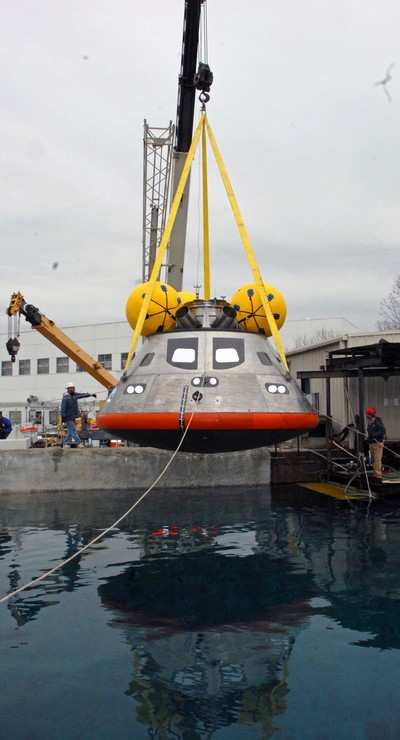
"We know a lot about the aerodynamic properties of this shape,"
said Alan Rhodes, NASA's Constellation Program test and
verification officer. "It's a great, great craft for space.
"It's not a great boat," he deadpanned.
Because the new spacecraft replaces the space shuttle, which has
landed on runways, the Constellation Project team needs to be able
to tell today's astronauts what to expect when they splash down in
the ocean after a mission. The team also needs to develop best
practices for getting the astronauts out of the capsule and
recovering the vehicle after splashdown. Toward those goals, the
Orion crew module was brought to the calm waters of the test pond
at the Naval Surface Warfare Center's Carderock Division in
Bethesda, Md., in late March.
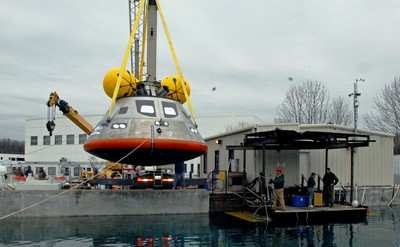
No people have been aboard the capsule for any of the testing
there, however. That will come later. Preliminary tests results
have been gained through observation and instrumentation.
"The key here is safety," Rhodes said. "It's kind of ... 'learn
as quick as possible,' but we've got to make sure we're safe,
because we don't want anybody getting hurt with this." Developing
best practices for deploying the module's floatation collar is much
safer in the pond's calm waters than in 10-foot seas, Rhodes
explained.
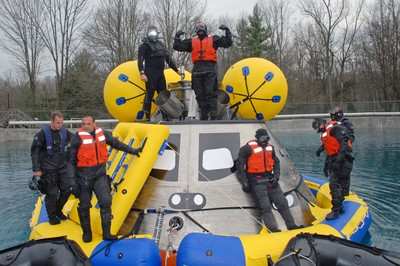
The procedure began by lowering the 18,000-pound module into the
water while team members guided it toward the center with ropes.
Once it was in position, two teams of Air Force pararescuemen in
rigid, inflatable Zodiac boats attached a sea anchor before
deploying and inflating an 18-inch floatation collar. The sea
anchor is the first step to slowing the motion of the capsule,
which helps to make the crew more comfortable, officials
explained.
Once inflated and attached to the module, the blue-and-yellow
collar stabilizes the craft further and provides the recovery crew
a platform from which to help the astronauts out of the
vehicle.
"The Air Force guys are able to use this test pool to test out
all the procedures they're going to want to use when we go to the
ocean," Rhodes said. They also got to test out a procedure they
hope they won't have to use when the main hatch on the side of the
module failed to open properly during the tests. This glitch, which
later was easily explained, had the recovery crew looking to the
alternate hatch on top of the vehicle.
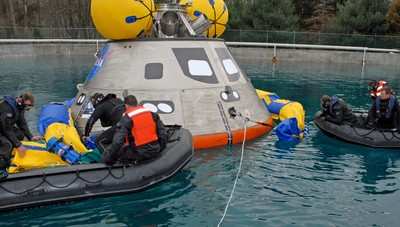
"On top, ... there's a secondary hatch called the docking
hatch," Rhodes said. "That'll be the hatch they use to enter the
space station [or] to attach themselves to the lunar lander [or]
the Martian vehicles. It also is a secondary egress path." The team
also should be able to tell the astronauts what to expect in
different sea states, he said.
"It helps us understand, 'We think you will have this
probability of being sick due to the motions.' 'We think you'll be
able to move based on our interpretation of these motions in these
manners,'" Rhodes explained. When all the testing on the Orion crew
module is complete the Constellation Project team will have
developed best practices for retrieving the crew and recovering the
capsule in just about any sea state, Rhodes said.
"It's extremely important to us to make sure that they can
[recover the vehicle and crew] in 10-, 12-, and 14-foot seas," said
Don Pearson, project manager for the post-landing test. "The reason
for that is we want to have what's called a very high launch
probability. Any day of the year I want to be able to launch my
spacecraft from Kennedy [Space Center]. We have to be able to say,
'Yeah, we've got really rough weather off Boston, but not a
problem. We could still pick you guys up [if the capsule splashed
down there]. Let's go. Let's launch today.'"
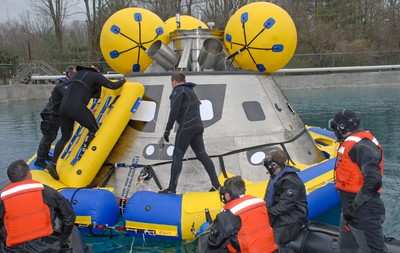
While the capsule has a retro look, sentiment was not what led
NASA to resume water landings upon re-entry; it was practicality.
While the Russian space program has the expansive, soft soils of
Kazakhstan on which to land their Soyuz spacecraft, the United
States is not so fortunate.
"Weight is the biggest issue, and a system that can keep the
astronauts safe landing on land," said Navy Cmdr. Andy Quiett, the
Defense Department's liaison to NASA for the Constellation Program.
"We don't have quite that big a [piece of] real estate in the
U.S.
"There are several landing sites that they've evaluated," he
continued, "and NASA made the call that weight costs money to put
[the capsule] into orbit and to have a system to protect the
capsule for a land landing. I know the astronaut office wants the
safest landing they can have, and the water landing provides
that."
The last splashdown of a crew module was Apollo 17, Quiett said.
That was Dec. 19, 1972. The team's consensus during a post-test
debrief was that all had gone well and they were on the right
track. That didn't mean they were done, however. The group took a
break before returning to the pond to run through the same exercise
at night. [ANN Salutes Samantha L. Quigley, American Forces Press
Service]
 Aero-News: Quote of the Day (04.17.24)
Aero-News: Quote of the Day (04.17.24) ANN's Daily Aero-Linx (04.17.24)
ANN's Daily Aero-Linx (04.17.24) Airborne-Flight Training 04.17.24: Feds Need Controllers, Spirit Delay, Redbird
Airborne-Flight Training 04.17.24: Feds Need Controllers, Spirit Delay, Redbird Airborne 04.16.24: RV Update, Affordable Flying Expo, Diamond Lil
Airborne 04.16.24: RV Update, Affordable Flying Expo, Diamond Lil Airborne 04.11.24: SnF24!, King's 50th, Top Rudder, Aileronics
Airborne 04.11.24: SnF24!, King's 50th, Top Rudder, Aileronics







